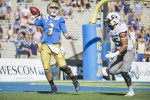People get too caught up in the age-old debate about whether collegiate athletes should be paid or not. In reality, what we really should be discussing is whether these individuals have the rights to their own likenesses.
The two are obviously related, but the second question is far more straightforward than the first and ought to be resolved immediately.
Under current restrictions, student-athletes cannot profit off of commercial opportunities, whether it be a jersey sale with their number on the back or using their own image to secure endorsement deals.
There’s been movement against these regulations – we can thank UCLA’s own Ed O’Bannon for that – but the NCAA continues to fight against it with the full legal force afforded to a multi-billion dollar institution.
Just a few weeks ago, the NCAA quietly asked the Supreme Court to take up O’Bannon’s athlete compensation case, which has been winding through the legal system for some time now. The national organization hopes that the nation’s highest court will reaffirm the amateurism rules that have unfairly bound young athletes for so many years.
Recently, with UCLA’s $280 million Under Armour deal and Josh Rosen’s snappy response online, debates over compensation have re-emerged on the national scene.
Too often, though, the argument is focused around whether an academic scholarship, a stipend and other privileges – priority registration, anybody? – is enough for these college students.
While this is likely my final column until 2017, I’ll save my opinion on that issue for a future take, as it is more nuanced and would take a few thousand words of its own. The real issue at hand surrounds corrupt NCAA policies, which eliminate any possibility that collegiate athletes might make a buck off of their own image.
These students – no matter whether they have valuable name recognition or if they’re just one of the many thousands on rosters nationwide – are held under the NCAA’s thumb in the name of “amateurism.”
Come on, now.
If 1,000 people want to pay $20 for a Lonzo Ball signature, let the kid collect his money. If In-N-Out Burger wants Jordin Canada to be its official SoCal spokeswoman, let her negotiate that deal. She’s earned it.
If players need financial help, they should be allowed to approach a local Westwood business, offering publicity in exchange for a sponsorship that might alleviate day-to-day burdens.
The issue becomes more controversial when you start advocating for or against additional payment from the school or the NCAA to athletes. It’s plenty more complex, too, when you try to compare athletes who take part in revenue vs. nonrevenue sports.
But if these really are amateurs, as the national organization would like you to believe, then how did the industry ever get to the inflated point that we find ourselves at now? The billion-dollar TV deals, the million-dollar salaries at the top of the NCAA food chain.
I guess keeping the already-unpaid labor in check by taking their rights to commercial opportunities was just too obvious of a move.
What it comes down to is the simple fact that the NCAA has used, is using and will continue to use athletes – limiting their financial opportunities to further line the pockets of those running the billion-dollar show.
Something needs to change.
It starts with Ed O’Bannon and the right to one’s own image.
It starts when we realize few other industries operate with such a flawed system of labor.
It starts when we stand up to the corporate interests of the NCAA and pay attention to the silenced voices of our collegiate athletes.
